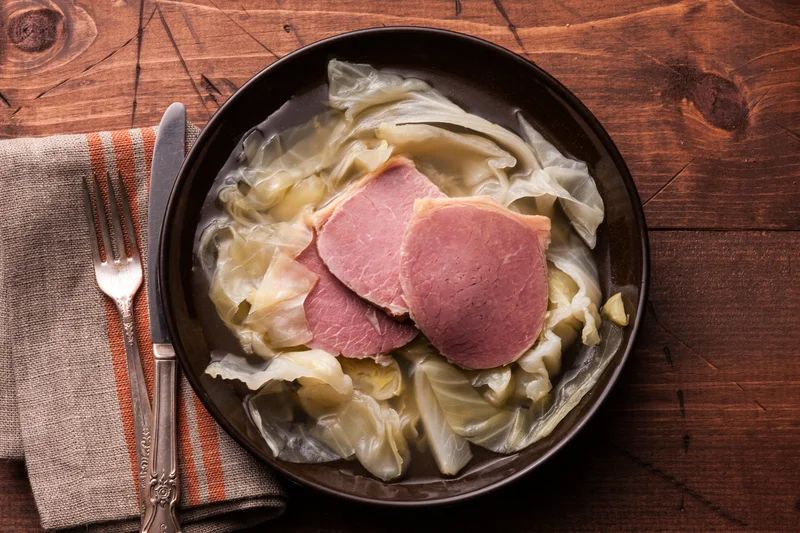Aaron Rocchino owns The Local Butcher Shop in Berkeley, California.
I’m a firm believer that good food takes time, and this corned beef recipe is a demonstration of that. It calls for a 12-day cure, which brings out the best texture and flavor from a piece of grass-fed beef. Sometimes I use brisket, the classic corned beef cut, but it has a lot of interior fat that doesn’t render out in the cooking. It’s good for sandwiches, where it’s sliced thin and you get a little fat and lean in every bite. But for St. Patrick’s Day, when you want to serve slices of corned beef on a plate, I go with the eye of round, a leaner cut from behind the upper leg. If you plan to serve cabbage with your corned beef, poach it in the strained broth after the meat’s done. Same with small, skin-on potatoes, a starchy variety like butterballs or Yukon Golds. Chopped flat-leaf parsley adds a nice green, springy flavor, or mix parsley with grated lemon zest, like a gremolata without garlic. Serve whole-grain mustard on the side. Whatever you do, don’t make it look too fancy—corned beef and cabbage is a rustic dish. Leftovers make great sandwiches. Heat any leftover broth and serve it on the side, French dip–style.
What to buy: I use fine sea salt rather than coarse kosher salt since it measures out more accurately by volume. For the curing salt (essential for preserving the beef’s rosy color) I use Insta Cure No. 1, which is salt with 6 percent sodium nitrite. Buy it online (maybe go in on a bag with friends), or see if you can buy a small amount from your local butcher.
- Yields: 8 to 10 servings
- Difficulty: Easy
- Total: 4 hrs, plus 12 1/2 days for curing and cooling
- Active: 30 mins
Ingredients (27)
For curing:
- 5 quarts cold water
- 2 1/4 cups fine sea salt
- 2/3 cups granulated sugar
- 4 medium garlic cloves, unpeeled and cut in half
- 2 teaspoons coriander seed
- 10 allspice berries
- 2 teaspoons yellow mustard seed
- 4 whole cloves
- 1 (3-inch) cinnamon stick
- Small handful black peppercorns
- 1/2 medium carrot, large dice
- 1/2 small yellow onion, large dice
- 1 to 2 bacon skins, also known as bacon rinds (optional)
- 1 bunch fresh thyme
- 3 fresh bay leaves
- 2 tablespoons pink curing salt such as Insta Cure No. 1
- 5 pounds beef eye of round, preferably from a grass-fed animal
For poaching:
- 4 garlic cloves, peeled
- 2 teaspoons coriander seed
- 10 allspice berries
- 2 teaspoons yellow mustard seed
- 4 whole cloves
- 1 (3-inch) cinnamon stick
- 1/2 medium carrot
- 1/2 small yellow onion
- 2 sprigs fresh thyme
- 3 fresh bay leaves
Instructions
To brine-cure the beef:
- Add the water to a large pot over medium-high heat. Add the salt, sugar, garlic, and all of the spices. Add the carrot, onion, and optional bacon skins.
- Bring the water to a boil. Give it a stir with a long-handled spoon to make sure the salt and sugar have dissolved. Turn off the heat and add the thyme and bay leaves.
- Let the brine cool to room temperature, allowing the aromatics to steep, about 2 hours. Add the pink curing salt and stir to dissolve.
- Transfer the brine to whatever refrigerator container you plan to store the beef in: a high-sided hotel pan, low plastic container, or even a large oven dish made of some nonreactive material like glass or earthenware. Refrigerate the brine overnight, or until it’s completely cold.
- Add the beef to the chilled brine, making sure it’s completely submerged. To make sure it stays submerged, lay a clean, folded kitchen towel directly onto the beef, than lay a clean plate or platter on top of the towel. Cover tightly with a lid or plastic film and refrigerate for 12 days. Check the container once a day to make sure the meat is still submerged.
To poach the corned beef:
- After the 12 days are up, lift the beef out of the brining liquid and transfer it to a pot large enough to hold the meat without too much crowding, but not so large that it gets lost. An oval Dutch oven is perfect; a large stainless steel pasta pot with a heavy bottom will work just fine. Discard the brining liquid, including the aromatics.
- Add enough cold water to the pot to cover the meat by 1 to 2 inches and set over medium heat. Add the garlic cloves, coriander, allspice, mustard, cloves, cinnamon, carrot, onion, thyme, and bay leaves.
- Once the liquid comes to a boil, reduce the heat to low and keep monitoring it: You want the surface of the liquid to tremble very gently in a few places—if you see big, vigorous bubbles, reduce the heat even further. Simmer the corned beef, uncovered, until the internal temperature registers 160°F on a meat thermometer, about 3 to 4 hours. (For brisket, cook until the internal temperature registers between 180°F and 185°F.)
- Remove the pot from the heat, leaving the corned beef in its broth to cool down gently to a warm temperature, about 1 hour. Remove from the liquid and slice. Strain the broth, and either serve it on the side in warmed bowls like consommé, or serve the corned beef slices in warmed shallow bowls and ladle some of the broth over the meat. You can poach a head of green cabbage, cored and cut into 6 wedges, in the strained broth until it’s tender, about 10 to 15 minutes.


